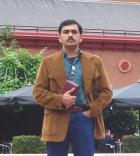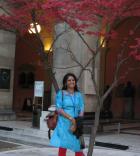The Nehru Trust grant funded a return trip to India. Since then I have been back a couple of times a year to try and complete this substantial project. The trip seeded two books and a huge amount of work. The grant also helped fund a translation team in Mehrangarh which worked on finding relevant bahis and translating texts from Marwari, Gujerati and Marathi.
Custom Search 1
Recipients

Robert Elgood
Cataloguing the collections of arms in the Mehrangarh Fort, Jodhpur

Shovana Sarangi
Warli and Weave: training in the children's museum
During the fellowship I worked with staff at the Museum of Childhood in Bethnal Green to facilitate a workshop for school children and adults in conjunction to the exhibition Warli and Weave. Drawing on work from Thane and Kutch in Western India the exhibition presented a special insight into two areas of contemporary Indian craft practice – Warli painting and weave. I prepared a learning pack for teachers and produced a temporary exhibition of artwork made by children in our workshop – ‘Top to Toe: Fashion for Kids’.

Vikram Singh
Paper conservation internship at the V&A Museum in London
My main goal through this internship was to gain practical and theoretical knowledge of advanced techniques in the field of paper conservation. To achieve this goal I was involved in the conservation of a number of miniature paintings, and simultaneously I made visits to various conservation international institutions to interact with working paper conservation experts and to get information about on-going techniques in the field.

Bishnupriya Basak
Understanding the antiquity of mankind: Interpretation of past human behaviour from archaeological artefacts with special reference to stone tools
The Nehru Trust award allowed me to visit the archives and manuscript collections of the Royal Anthropological Institute, London, and Indian Collections housed in the Pitt Rivers Museum, Oxford. The ambition of my project was to better consider the beginnings of prehistoric archaeology in the Indian sub-continent with special reference to eastern India.

Sila Tripati
Monsoons and the Maritime: Trade in India from an archaeological perspective
Before the discovery of the monsoon winds by Hippalus in AD 45–47, the mariners of the east coast of India were aware of the monsoon wind and currents and used them for maritime trade. The maritime trade from India to Southeast Asia was a seasonal phenomenon. The distribution of Buddhist settlements, discovery of varieties of pottery, beads and inscriptions along the ports and trade centres point to active maritime trade between India and Southeast Asia.
Kristina Mandy
The 'Sword of Damocles' conservation treatment project.
The Nehru travel award was for a placement on a paintings conservation project at the Chatrapati Shivaji Maharaj Vastu Sangrahalaya (CSVMS) Museum in Mumbai, India.
During the placement I treated an oil painting on canvas titled The Sword of Damocles by Antoine Dubost. I participated in this treatment with my classmate Pearl O'Sullivan, two Courtauld Institute of Art graduates Harriet Pearson and Mark Coombs, and under the supervision of senior conservator Anupam Sah and Professor Aviva Burnstock.
